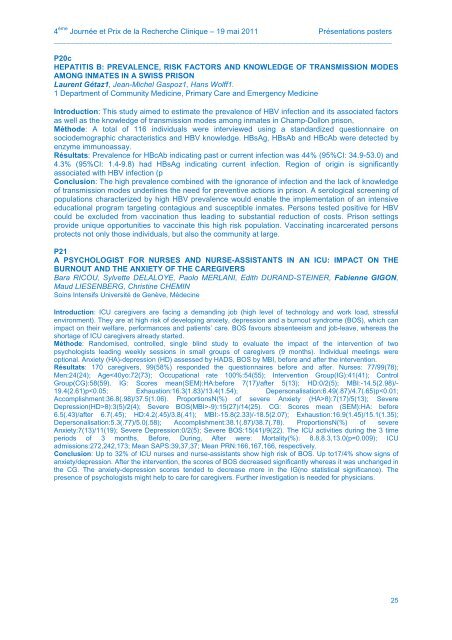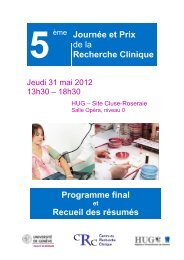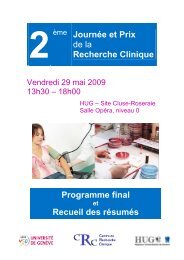Programme final et Recueil des résumés - Centre de recherche ...
Programme final et Recueil des résumés - Centre de recherche ...
Programme final et Recueil des résumés - Centre de recherche ...
You also want an ePaper? Increase the reach of your titles
YUMPU automatically turns print PDFs into web optimized ePapers that Google loves.
4 ème Journée <strong>et</strong> Prix <strong>de</strong> la Recherche Clinique – 19 mai 2011 Présentations posters<br />
________________________________________________________________________________<br />
P20c<br />
HEPATITIS B: PREVALENCE, RISK FACTORS AND KNOWLEDGE OF TRANSMISSION MODES<br />
AMONG INMATES IN A SWISS PRISON<br />
Laurent Gétaz1, Jean-Michel Gaspoz1, Hans Wolff1.<br />
1 Department of Community Medicine, Primary Care and Emergency Medicine<br />
Introduction: This study aimed to estimate the prevalence of HBV infection and its associated factors<br />
as well as the knowledge of transmission mo<strong><strong>de</strong>s</strong> among inmates in Champ-Dollon prison,<br />
Métho<strong>de</strong>: A total of 116 individuals were interviewed using a standardized questionnaire on<br />
socio<strong>de</strong>mographic characteristics and HBV knowledge. HBsAg, HBsAb and HBcAb were d<strong>et</strong>ected by<br />
enzyme immunoassay.<br />
Résultats: Prevalence for HBcAb indicating past or current infection was 44% (95%CI: 34.9-53.0) and<br />
4.3% (95%CI: 1.4-9.8) had HBsAg indicating current infection. Region of origin is significantly<br />
associated with HBV infection (p<br />
Conclusion: The high prevalence combined with the ignorance of infection and the lack of knowledge<br />
of transmission mo<strong><strong>de</strong>s</strong> un<strong>de</strong>rlines the need for preventive actions in prison. A serological screening of<br />
populations characterized by high HBV prevalence would enable the implementation of an intensive<br />
educational program targ<strong>et</strong>ing contagious and susceptible inmates. Persons tested positive for HBV<br />
could be exclu<strong>de</strong>d from vaccination thus leading to substantial reduction of costs. Prison s<strong>et</strong>tings<br />
provi<strong>de</strong> unique opportunities to vaccinate this high risk population. Vaccinating incarcerated persons<br />
protects not only those individuals, but also the community at large.<br />
P21<br />
A PSYCHOLOGIST FOR NURSES AND NURSE-ASSISTANTS IN AN ICU: IMPACT ON THE<br />
BURNOUT AND THE ANXIETY OF THE CAREGIVERS<br />
Bara RICOU, Sylv<strong>et</strong>te DELALOYE, Paolo MERLANI, Edith DURAND-STEINER, Fabienne GIGON,<br />
Maud LIESENBERG, Christine CHEMIN<br />
Soins Intensifs Université <strong>de</strong> Genève, Mé<strong>de</strong>cine<br />
Introduction: ICU caregivers are facing a <strong>de</strong>manding job (high level of technology and work load, stressful<br />
environment). They are at high risk of <strong>de</strong>veloping anxi<strong>et</strong>y, <strong>de</strong>pression and a burnout syndrome (BOS), which can<br />
impact on their welfare, performances and patients’ care. BOS favours absenteeism and job-leave, whereas the<br />
shortage of ICU caregivers already started.<br />
Métho<strong>de</strong>: Randomised, controlled, single blind study to evaluate the impact of the intervention of two<br />
psychologists leading weekly sessions in small groups of caregivers (9 months). Individual me<strong>et</strong>ings were<br />
optional. Anxi<strong>et</strong>y (HA)-<strong>de</strong>pression (HD) assessed by HADS, BOS by MBI, before and after the intervention.<br />
Résultats: 170 caregivers, 99(58%) respon<strong>de</strong>d the questionnaires before and after. Nurses: 77/99(78);<br />
Men:24(24); Age-9):15(27)/14(25). CG: Scores mean (SEM):HA: before<br />
6.5(.43)/after 6.7(.45); HD:4.2(.45)/3.8(.41); MBI:-15.8(2.33)/-18.5(2.07); Exhaustion:16.9(1.45)/15.1(1.35);<br />
Depersonalisation:5.3(.77)/5.0(.58); Accomplishment:38.1(.87)/38.7(.78). ProportionsN(%) of severe<br />
Anxi<strong>et</strong>y:7(13)/11(19); Severe Depression:0/2(5); Severe BOS:15(41)/9(22). The ICU activities during the 3 time<br />
periods of 3 months, Before, During, After were: Mortality(%): 8.8,8.3,13.0(p=0.009); ICU<br />
admissions:272,242,173; Mean SAPS:39,37,37; Mean PRN:166,167,166, respectively.<br />
Conclusion: Up to 32% of ICU nurses and nurse-assistants show high risk of BOS. Up to17/4% show signs of<br />
anxi<strong>et</strong>y/<strong>de</strong>pression. After the intervention, the scores of BOS <strong>de</strong>creased significantly whereas it was unchanged in<br />
the CG. The anxi<strong>et</strong>y-<strong>de</strong>pression scores ten<strong>de</strong>d to <strong>de</strong>crease more in the IG(no statistical significance). The<br />
presence of psychologists might help to care for caregivers. Further investigation is nee<strong>de</strong>d for physicians.<br />
25






